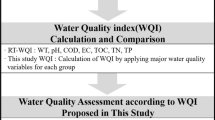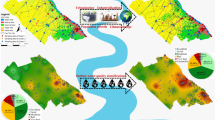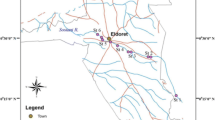Abstract
This research aimed to investigate the long-term spatiotemporal changes of surface water quality of the Maroon River by implementing Water Quality Index (WQI) and multivariate statistical analyses such as non-metric multidimensional scaling and cluster analyses, as complementary tools to investigate spatial variations in water quality parameters and also delineate areas in terms of water quality conditions in the period under study. The other purposes of this study were to evaluate the physicochemical properties of the Maroon River water and assess the effects of each water quality parameter on the WQI values. Relationship between quality scale of hydrochemical parameters and the resulting WQI scores was determined employing linear regression analysis. Moreover, the suitability of water quality was evaluated for irrigation purposes using conventional indices, electrical conductivity (EC), sodium adsorption ratio (SAR), and percent sodium (Na%). The monitoring stations were placed in high and very high categories according to the assessment of irrigation water quality with EC. Considering WQI, the upper (S1, S2, and S4) and lower (S3, S5, and S6) monitoring stations of the Maroon River distributed in category C3 (high salinity) and C4–C5 (very high salinity), respectively. The findings of WQI presented an increasing trend from upstream toward downstream in the Maroon River. The findings of the linear regression analysis showed no significant correlation between WQI scores with pH and SO4 2− concentrations even though the relationship is weak. These results suggest that pH and SO4 2− concentrations could be the secondary driving parameters behind the variations in WQI scores. It can be inferred that the Maroon River water is appropriate for irrigation based on Na% and SAR. However, it also exhibits high EC. Therefore, for mitigating the adverse impacts of polluted water authors recommend multidimensional management practices such as transferable discharge permit programs in the study area.





Similar content being viewed by others
References
APHA (1989) Standard methods for the examination of water and wastewater. Washington, DC
Asadi Kapourchal S, Homae M, Pazira E (2013) Modeling leaching requirement for desalinization of saline soils. J Soil Water Resour Conserv 2(2):65–83 (in Persian)
Atazadeh I, Sharifi M, Kelly M (2007) Evaluation of the Trophic Diatom Index for assessing water quality in River Gharasou, western Iran. Hydrobiologia 589:165–173
Bu H, Meng W, Zhang Y, Wan J (2014) Relationships between land use patterns and water quality in the Taizi River basin, China. Ecol Ind 41:187–197
Burt T, Howden N, Worrall F (2014) On the importance of very long-term water quality records. Wiley interdisciplinary reviews. Water 1:41–48
Causapé J, Quílez D, Aragüés R (2004) Assessment of irrigation and environmental quality at the hydrological basin level: II. Salt and nitrate loads in irrigation return flows. Agric Water Manag 70:211–228
Chapman DV, Organization WH (1996) Water quality assessments: a guide to the use of biota, sediments and water in environmental monitoring. E & Fn Spon, Cambridge, London
Chen J, Wu X, Finlayson BL, Webber M, Wei T, Li M, Chen Z (2014) Variability and trend in the hydrology of the Yangtze River, China: annual precipitation and runoff. J Hydrol 513:403–412
Clarke K, Warwick R (2001) Change in marine communities: an approach to statistical analysis and interpretation. PRIMER-E, Plymouth
Edet A, Ukpong A, Nganje T (2013) Hydrochemical studies of Cross River Basin (southeastern Nigeria) river systems using cross plots, statistics and Water Quality Index. Environ Earth Sci 70:3043–3056
Egdernezhad A, Jamshidi AR (2015) Soil desalinization and land reclamation in East Khuzestan Plains, Khuzestan Province. Res J Fish Hydrobiol 10:242–249
Fazli RA, Gholami A, Andarzian B, Ghoosheh M (2013) Investigating the effect of applying drainaged-water on wheat yield using SALTMED model. J Novel Appl Sci 2(S3):1003–1011
Handa B (1969) Description and classification of media for hydro-geochemical investigations. In: Symposium on ground water studies in arid and semiarid regions
Hou W, Sun S, Wang M, Li X, Zhang N, Xin X, Sun L, Li W, Jia R (2016) Assessing water quality of five typical reservoirs in lower reaches of Yellow River, China: using a Water Quality Index method. Ecol Ind 61:309–316
Kazi T, Arain M, Jamali MK, Jalbani N, Afridi H, Sarfraz R, Baig J, Shah AQ (2009) Assessment of water quality of polluted lake using multivariate statistical techniques: a case study. Ecotoxicol Environ Saf 72:301–309
Keshtkar A, Mahdavi M, Salajegheh A, Ahmadi H, Sadoddin A (2011) Exploring the relationship between land use and surface water quality using multivariate statistics in arid and semi-arid regions. Desert 16:33–38
Lumb A, Sharma T, Bibeault JF (2011) A review of genesis and evolution of Water Quality Index (WQI) and some future directions. Water Qual Expos Health 3:11–24
Mohsenifar K, Pazira E, Najafi P (2006) Evaluation different type of leaching models in two pilots of South East Khuzestan province. J Res Agric Sci IAU Esfahan Iran 2(1):73–92 (in Persian)
Mostafaei A (2014) Application of multivariate statistical methods and water-quality index to evaluation of water quality in the Kashkan River. Environ Manag 53:865–881
Nasirian M (2007) A new Water Quality Index for environmental contamination contributed by mineral processing: a case study of Amang (Tin Tailing) processing activity. J Appl Sci 7:2977–2987
Noori R, Sabahi MS, Karbassi A, Baghvand A, Zadeh HT (2010) Multivariate statistical analysis of surface water quality based on correlations and variations in the data set. Desalination 260:129–136
Perrin JL, Raïs N, Chahinian N, Moulin P, Ijjaali M (2014) Water quality assessment of highly polluted rivers in a semi-arid Mediterranean zone Oued Fez and Sebou River (Morocco). J Hydrol 510:26–34
Pesce SF, Wunderlin DA (2000) Use of water quality indices to verify the impact of Córdoba City (Argentina) on Suquía River. Water Res 34:2915–2926
Qureshi AS, Qadir M, Heydari N, Turral H, Javadi A (2007) A review of management strategies for salt-prone land and water resources in Iran. IWMI Working Paper 125. International Water Management Institute, Colombo, p 30
Raghunath HM (1987) Ground water. New Age International, Seborga
Rahi KA, Halihan T (2010) Changes in the salinity of the Euphrates River system in Iraq. Reg Environ Change 10:27–35
Razmkhah H, Abrishamchi A, Torkian A (2010) Evaluation of spatial and temporal variation in water quality by pattern recognition techniques: a case study on Jajrood River (Tehran, Iran). J Environ Manag 91:852–860
Richards L (1954) Diagnosis and improvement of saline and alkali soils. USDA Agriculture Handbook 60. United States Salinity Laboratory, Washington, p 160
Sadeghi S, Jalili K, Nikkami D (2009) Land use optimization in watershed scale. Land Use Policy 26:186–193
Sahu P, Sikdar P (2008) Hydrochemical framework of the aquifer in and around East Kolkata Wetlands, West Bengal, India. Environ Geol 55:823–835
Sánchez E, Colmenarejo MF, Vicente J, Rubio A, García MG, Travieso L, Borja R (2007) Use of the Water Quality Index and dissolved oxygen deficit as simple indicators of watersheds pollution. Ecol Ind 7:315–328
Şener Ş, Şener E, Davraz A (2017) Evaluation of water quality using Water Quality Index (WQI) method and GIS in Aksu River (SW-Turkey). Sci Total Environ 584:131–144
Sharifinia M (2016) Comment on “Hydrochemical studies of Cross River Basin (southeastern Nigeria) river systems using cross plots, statistics and Water Quality Index” published in Environ. Environ Earth Sci 70:3043–3056
Sharifinia M, Ramezanpour Z, Imanpour J, Mahmoudifard A, Rahmani T (2013) Water quality assessment of the Zarivar Lake using physico-chemical parameters and NSF-WQI indicator, Kurdistan Province-Iran. Int J Adv Biol Biomed Res 1:302–312
Sharifinia M, Mahmoudifard A, Namin JI, Ramezanpour Z, Yap CK (2016a) Pollution evaluation in the Shahrood River: Do physico-chemical and macroinvertebrate-based indices indicate same responses to anthropogenic activities? Chemosphere 159:584–594
Sharifinia M, Mahmoudifard A, Gholami K, Namin JI, Ramezanpour Z (2016b) Benthic diatom and macroinvertebrate assemblages, a key for evaluation of river health and pollution in the Shahrood River, Iran. Limnology 17:95–109
Sliva L, Williams DD (2001) Buffer zone versus whole catchment approaches to studying land use impact on river water quality. Water Res 35:3462–3472
Smedema LK, Shiati K (2002) Irrigation and salinity: a perspective review of the salinity hazards of irrigation development in the arid zone. Irrigat Drain Syst 16:161–174
Tabari H, Marofi S, Ahmadi M (2011) Long-term variations of water quality parameters in the Maroon River, Iran. Environ Monit Assess 177:273–287
Taherizadeh M, Sharifinia M (2015) Applicability of ecological benthic health evaluation tools to three subtropical estuaries (Azini, Jask and Khalasi) from the Iranian coastal waters. Environ Earth Sci 74:3485–3499
Todd DK, Mays LW (2005) Groundwater hydrology. Wiley, New Jersey
Turekian K (1977) Geochemical distribution of elements. Encycl Sci Technol 4:627–630
Varanka S, Hjort J (2017) Spatio-temporal aspects of the environmental factors affecting water quality in boreal rivers. Environ Earth Sci 76:21
Whitehead P, Wilby R, Battarbee R, Kernan M, Wade AJ (2009) A review of the potential impacts of climate change on surface water quality. Hydrol Sci J 54:101–123
World Health Organization (WHO) (1984) Guidelines for drinking water quality, 2nd edn. WHO, Geneva
World Health Organization (WHO) (1993) Guidelines for drinking water quality: health criteria and other supporting information, 2nd edn. WHO, Geneva
Yidana SM, Yidana A (2010) Assessing water quality using Water Quality Index and multivariate analysis. Environ Earth Sci 59:1461–1473
Yu S, Xu Z, Wu W, Zuo D (2016) Effect of land use types on stream water quality under seasonal variation and topographic characteristics in the Wei River basin, China. Ecol Ind 60:202–212
Zhai X, Xia J, Zhang Y (2014) Water quality variation in the highly disturbed Huai River Basin, China from 1994 to 2005 by multi-statistical analyses. Sci Total Environ 496:594–606
Acknowledgements
The authors would like to appreciate Khuzestan Water and Power Authority for providing the water quality data for the Maroon River. Many thanks to Mostafa Adibnezhad and Vali Sheikhy for his help and technical advices. We also would like to appreciate the Editor and anonymous reviewers who provided valuable feedback on previous versions of this manuscript.
Author information
Authors and Affiliations
Corresponding author
Ethics declarations
Conflict of interest
The authors declare that they have no conflict of interest.
Rights and permissions
About this article
Cite this article
Sharifinia, M., Adeli, B. & Nafarzadegan, A.R. Evaluation of water quality trends in the Maroon River Basin, Iran, from 1990 to 2010 by WQI and multivariate analyses. Environ Earth Sci 76, 781 (2017). https://doi.org/10.1007/s12665-017-7132-5
Received:
Accepted:
Published:
DOI: https://doi.org/10.1007/s12665-017-7132-5




